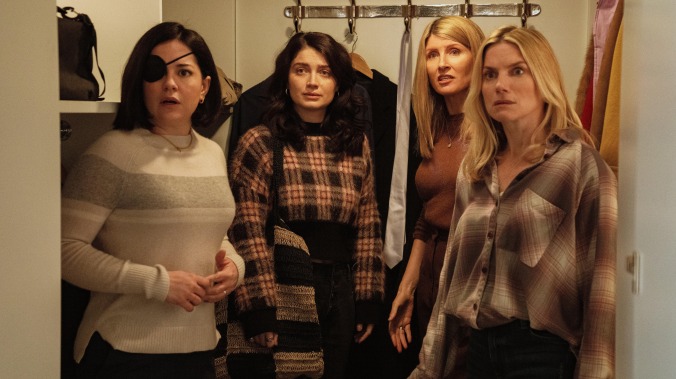Sharon Horgan breaks down that killer reveal from the Bad Sisters finale
The star and creator of Apple TV Plus' Bad Sisters talks about crafting despicable characters, those fabulous outfits, and the possibility of another season

[The following interview contains spoilers for the Bad Sisters finale. Proceed at your own risk.]
Take one glance at the impressive list of TV shows Sharon Horgan has crafted, from 2006’s Pulling to 2015’s Catastrophe to 2022’s Shining Vale, and it’s evident that she has a knack for writing impeccably relatable, empathetic, and flawed characters. Her skills are fully on display in Bad Sisters, the dramedy she created with Dave Finkel and Brett Baer as part of her recent deal with Apple. The series finale arrives October 14.
Bad Sisters is an Ireland-set mystery comedy based on the Flemish series Clan. It’s about four Garvey sisters—Eva (Horgan), Ursula (Eva Birthistle), Bibi (Sarah Greene), and Becka (Eve Hewson)—who plot the murder of their brother-in-law, John Paul, a.k.a. The Prick (Claes Bang). John Paul is a manipulative misogynist who ruined the life of their fifth sibling, his wife Grace (Anne-Marie Duff). In its final episode, Bad Sisters reveals how JP died and who killed him. Was it really the Garvey bunch, as suspected by the life insurance investigators? Yes and no. The episode, titled “Saving Grace,” reveals it was ultimately Grace who ended her husband’s life after realizing the true monster he is. The A.V. Club spoke to Horgan about the potential for a second season, changes she made to the script from Clan, and crafting a horrible character like John Paul.
The A.V. Club: Did you ever consider changing the ending from the original, or did you always know that you’d reveal Grace as the killer after she finally grasped the fact that her husband is a monster?
Sharon Horgan: In a writers’ room, you discuss every bit or version of what could happen. So we definitely had conversations about it, but that’s it. We did modify it a little from the original with the final reveal about Roger helping Grace out. To me, it felt like an extra satisfying twist. With the original, I didn’t quite believe she’d have the strength to do it on her own for practical reasons as well. I love to tie up as many ends as possible with a story like this, and it didn’t feel like Roger’s story was done. He ended up becoming such an important character for Grace. I think it was an oddly beautiful moment between them.
AVC: The final straw for Grace is when she learns John Paul assaulted Eva years ago, leading to her miscarriage. It’s an intense revelation, so I’m wondering how you wanted that scene to play out between all the Garvey sisters once the truth comes out.
SH: One of the many beautiful gifts from the original was that even there, that was the straw that breaks her. JP has beaten Grace down so conclusively at that point in the finale, there’s not much left of her. The revelation of what he did to Eva makes her snap because it brings back all the love the sisters share. Her sisters are essentially trying to murder a man to rescue her, and the fact is that Grace does it in the end out of love for Eva after seeing what he took away from her. That’s what I wanted to portray. What we did differently from the original is how Eva’s story is told. In that one, it happens in episode nine, and the assault is dramatized. For us, we always felt it would be more powerful told in words.
AVC: JP is obviously a despicable character. What were the challenges of crafting someone like him for 10 hourlong episodes? Did you find it traumatizing?
SH: It wasn’t necessarily traumatizing, but it was a real responsibility, especially because we were trying to balance comedy and drama. There are lots of aspects to his personality. Sometimes he’s viciously awful, and then he’s having a tender moment with his daughter. Combining all those things and finding an actor to portray them, it had to be someone who isn’t afraid to be a clown, because part of the reason why he’s The Prick is that he feels he isn’t taken seriously enough. How can he be taken seriously when he’s a fool, you know? It’s just that some people don’t see it, but Grace’s sisters see it clearly. It was juggling all those aspects. He’s a sadist, misogynist, racist, and abuser, and at the same time, the audience has to be drawn to watching him. They can’t be so repulsed that they don’t even want to be around him. He’s a pure love-to-hate guy who also has to be riveting to watch. And Claes Bang is, isn’t he?








































